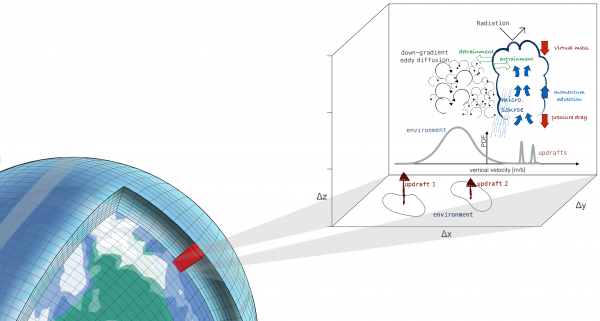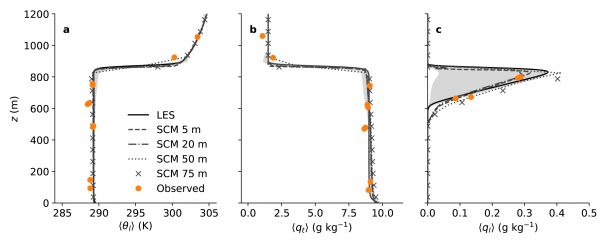The dynamics of clouds and turbulence play a profoundly important role in the climate system, yet their scales are often too small to be resolved faithfully in global climate models. Therefore, climate models rely on subgrid-scale parameterizations for representing clouds and turbulence, which remain the most significant aspect of physical uncertainty in climate predictions. The wide range of cloud and turbulence regimes that occur in nature are often challenging to represent in a single parameterization.

Research Scientist Yair Cohen, Postdoctoral Scholar Jia He, Graduate Student Ignacio Lopez-Gomez and their colleagues have presented a parameterization that does capture this wide range of cloud and turbulence systems within a single, unified physical framework, aiming to reproduce the average effect of turbulent heat and moisture transport under all atmospheric conditions. “Our aim was to construct a model of turbulence and convection general enough to represent the dynamics of Earth’s clouds, from the equator to the poles, while respecting the laws of physics. Although modern emulators like deep neural networks are great at learning, it is difficult to guarantee that they will remain accurate in future climates, or that they will conserve mass and energy. Our proposed model ensures these conservation principles are respected,“ says Lopez-Gomez. The accuracy of this parameterization in representing turbulence in atmospheric boundary layers under both stable and convective conditions is demonstrated by numerical simulations.

The framework of the parameterization is defined by a decomposition of turbulent flows into convective plumes and a more chaotic environment. “A key contribution of this work is showing how the exchange of mass and properties between the plumes and their turbulent environment—the so-called entrainment and detrainment of air into and out of plumes—can be modeled. We show that the resulting parameterization represents well the most important features of dry convective boundary layers, shallow cumulus convection, and deep cumulonimbus convection,” says Cohen.

Jia He’s work focuses on correctly modeling the momentum exchange between plumes and the environment in this unified framework. “Through analysis of an idealized flow configuration, we were able to derive analytically the effect of physical processes that are missing in most models.” says Jia. This new approach leads to increased accuracy in simulations of the diurnal cycle of deep convection, intimately related to rain events in the tropics.

ClimateMachine has been designed and optimized to run on both CPUs and GPUs. With preliminary tests on both LES and global climate simulations, ClimateMachine has shown considerable scalability which will enable convection-resolving global atmosphere simulations in the near future. Through subgrid-scale parameterizations that accurately represent turbulence in the atmospheric boundary layer, including stratocumulus clouds, the Climate Modeling Alliance is making computational advances toward resolving small-scale uncertainties in climate models.
References:
Lopez-Gomez, I., Cohen, Y., He, J., Jaruga, A., Schneider, T., 2020: A generalized mixing length closure for eddy-diffusivity mass-flux schemes of turbulence and convection. Journal of Advances in Modeling Earth Systems, 12, e2020MS002161.
Cohen, Y., Lopez-Gomez, I., Jaruga A., He, J., Kaul, C. M., Schneider, T., 2020: Unified entrainment and detrainment closures for extended eddy-diffusivity mass-flux schemes. Journal of Advances in Modeling Earth Systems, 12, e2020MS002162.
He, J., Cohen, Y., Lopez-Gomez, I., Jaruga, A., Schneider, T., 2020: An Improved Perturbation Pressure Closure for Eddy-Diffusivity Mass-Flux Schemes, Journal of Advances in Modeling Earth Systems, submitted.


